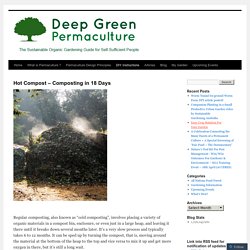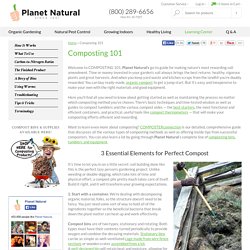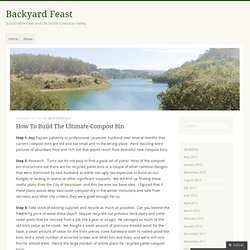

GAIACRAFT - Permaculture Composting. Sleeping under the trees on Yoshino mountainThe spring breeze wearingCherry blossom petals ~ Saigyo Permaculture and the Art of Composting deep in the work on an integrated compost system for the Heart of the Creek a small center in the little town of Roberts Creek nestled in the cedar trees against the wilds of the pacific ocean on the british columbian west coast with the kind and generous support of Lorinda and Don i have been empowered to create an integrated compost system as one shard in a mission to make the many gardens here into a community permaculture education space a living classroom where people can learn about plants, organic gardening and other ecologically conscious methods of sustainable design and development i thot i would illustrate my process as a way of opening up dialogues about permaculture composting techniques this will be a ritual post evolving with pictures as my process evolves.

Hot Compost – Composting in 18 Days « Deep Green Permaculture. Regular composting, also known as “cold composting”, involves placing a variety of organic materials in a compost bin, enclosure, or even just in a large heap, and leaving it there until it breaks down several months later.

It’s a very slow process and typically takes 6 to 12 months. It can be sped up by turning the compost, that is, moving around the material at the bottom of the heap to the top and vice versa to mix it up and get more oxygen in there, but it’s still a long wait. The other approach to composting is “hot composting”, which produces compost in a much shorter time. It has the benefits of killing weed seeds and pathogens (diseases), and breaking down the material into very fine compost. In contrast, cold composting does not destroy seeds, so if you cold compost weeds, any weed seeds will grow when you put the compost into the garden.
The requirements for hot composting using the Berkley method are as follows: Composting Materials and the Carbon-Nitrogen Balance Like this: Composting 101 - How to Make Compost. Welcome to COMPOSTING 101, Planet Natural’s go-to guide for making nature’s most rewarding soil amendment.

Time or money invested in your garden’s soil always brings the best returns: healthy, vigorous plants and great harvests. And when you keep yard waste and kitchen scraps from the landfill you’re doubly rewarded. You can buy ready-made, organic compost to get a jump start. But it’s easy and inexpensive to make your own with the right materials and good equipment. Here you’ll find all you need to know about getting started as well as maintaining the process no matter which composting method you’ve chosen. Want to learn even more about composting? 3 Essential Elements for Perfect Compost It’s time to let you in on a little secret: soil building done like this is the perfect lazy person’s gardening project. 1. Compost bins are of two types, stationary and rotating. When using the stationary bin method, locate the pile in a sunny location so that it has as much heat as possible. 2. 3. How To Build The Ultimate Compost Bin. Step 1: Beg Explain patiently to professional carpenter husband over several months that current compost bins are old and too small and in the wrong place.

Paint dazzling word pictures of abundant food and rich soil that would result from beautiful new compost bins. Step 2: Research. Turns out it’s not easy to find a good set of plans! Most of the compost bin instructions out there are for recycled pallet bins or a couple of other common designs that were dismissed by said husband as either too ugly, too expensive to build on our budget, or lacking in lateral or other significant supports. We did end up finding these useful plans from the City of Vancouver, and this became our base idea.
Step 3: Take stock of existing supplies and recycle as much as possible. Step 4: When the good weather arrives—start building! Before: Old 2-bin system falling apart. Preparing the new site perpendicular to the old one. Coming together: more salvaged and recycled cedar. Complete! The details… Like this: